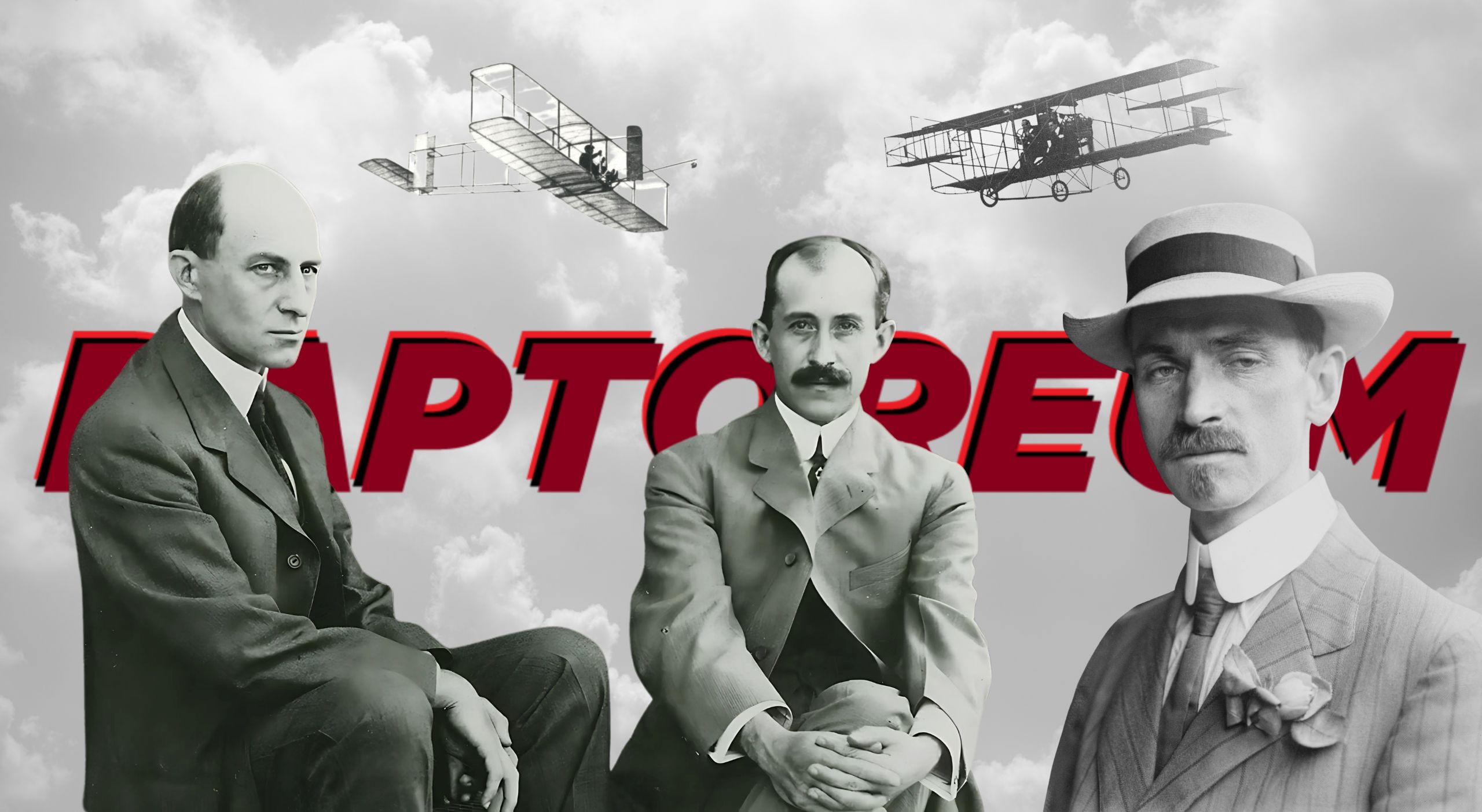We Asked Grok 3.0: Could Raptoreum Have Settled the Wright-Curtiss Feud?
March 26, 2025 | Raptoreum Team
What if Blockchain Technology Had Soared into Aviation’s Early Days?
Back in the 20th century, pioneers like the Wright Brothers and Glenn Curtiss were stuck wrestling over paper patents. It was a mess—think Edison vs. Tesla, but with wings. No digital ledger meant courtroom showdowns rivaled their sky races, stalling progress big time.
We got curious and asked Grok 3.0, xAI’s slick AI, a wild question: Could Raptoreum’s blockchain—today’s genius of unchangeable records—have sorted out the Wright-Curtiss feud? Buckle up—the answer’s a ride through innovation’s what-ifs.
The Storm Over the Skies
The Wrights Take Flight
By 1903, Orville and Wilbur Wright nailed the first powered, controlled flight. Their trick? Wing-warping—twisting the plane’s wings to steer. They locked it down with a patent in 1906 (U.S. Patent No. 821,393) after years of careful notes.
Wilbur, the chatty one, wasn’t shy about it. In a 1909 letter, he wrote:
“It’s not disputed that every person using this system today owes it to us and to us alone. The French aviators freely admit it” (The Papers of Wilbur and Orville Wright, ed. McFarland, 1953).
He even doubled down elsewhere:
“Morally, the world owes its use of lateral control entirely to us. Legally too” (The Bishop’s Boys by Tom Crouch, 1989).
Curtiss Crashes the Party
Then came Glenn Curtiss—a gutsy motorcycle guy turned aviation hotshot. In 1908, he rolled out ailerons—those handy wing flaps that made banking smoother and cleaner. The Wrights? They saw red. By 1909, they’d sued, claiming Curtiss ripped off their idea.
The legal fight got nasty. The Wrights argued that wing-warping and ailerons did the same job—controlling the plane side-to-side—so Curtiss was a thief. Curtiss didn’t blink:
“I’ve never used the Wright system or infringed their patent,” he told the press in 1910. “My ailerons are a distinct improvement, and I’ll fight this to the end” (Unlocking the Sky by Seth Shulman, 2002).
A Costly Clash
Courts dug through blueprints and arguments, siding with the Wrights in 1913. But it was a hollow win. The feud sucked up cash and time, grounding aviation’s big brains in lawyer-land. Wilbur summed it up in 1912, not long before typhoid took him out:
“When we think what we might’ve done if we’d focused on experiments, we feel very sad” (The Wright Brothers by David McCullough, 2015).
World War I finally forced a truce. With countries desperate for planes, the U.S. government set up a 1917 patent pool, making the rivals play nice. The war ended, but the cost was steep—years of lost breakthroughs. History cheers the Wrights as aviation’s dads, but Curtiss fans argue his ailerons (the actual future) got robbed by courtroom muscle, not merit.
Historical Evidence of the Dispute’s Messiness
A Patent Tug-of-War
The Wright-Curtiss mess was a snarl of “he said, she said” chaos—ripe for a fix. The Wrights’ 1906 patent had Wilbur crowing ownership. Curtiss, with his 1908 June Bug flight, fired back just as hard. That back-and-forth sparked the 1909-1913 lawsuit (Wright Co. v. Herring-Curtiss Co.).
Courts slogged through shaky testimony and fuzzy patent wording, handing the Wrights the win in 1913. But here’s the kicker—ailerons took over anyway. Octave Chanute, a pal to both sides, nailed it in 1909:
“The truth of invention is hard to pin down when ideas fly so freely” (The Papers of Wilbur and Orville Wright).
It was all talk, no proof—classic old-school patent drama.
Blockchain to the Rescue
Picture Raptoreum’s blockchain swooping in like a digital air traffic boss. Every sketch, test flight, and patent claim—locked in an unalterable chain.
- The Wrights’ wing-warping? Stamped as theirs in 1906.
- Curtiss’s ailerons? Clearly his, logged in 1908 with the June Bug’s big moment.
No more baseless lawsuits—blockchain’s crystal-clear records could’ve stopped the fight cold. Imagine them ditching court for hangars, building together. Curtiss dreamed of that vibe in 1909:
“Aviation’s too big for one man or company to hold back. It’s a science for the world” (Hero of the Air by William F. Trimble, 2010).
A Faster Takeoff
Beyond ending the feud, secure records could’ve pulled in investors, sped up licenses, and cut the red tape. The Wright-Curtiss clash might’ve sparked ideas, not attorney bills. Commercial flight a decade earlier? With blockchain lifting aviation’s wings, it’s easy to see.
For today’s creators, it’s a wake-up call: lock your stuff down, prove it’s yours, and fly past the noise.
Grok 3.0’s Takeoff: RTM as the Solution
How It Could’ve Worked
Grok 3.0 is all in on Raptoreum’s blockchain:
- Immutable Timestamps: Pinpoint who did what first—wing-warping vs. ailerons, no guesswork.
- Public Records: Show the world who owns what, dodging the Wrights’ blanket claims.
- Asset Explorer Verification: Let anyone, anywhere, check the facts—court delays vanish.
- Legal Gravitas: RTM records, tied to evidence rules, could’ve fast-tracked rulings.
- Updatable Assets: Tweak designs without losing your spot—collaboration, not combat.
A Bigger Impact
Grok sees a blockchain ledger nipping disputes in the bud. “Aviation might’ve soared sooner,” it figures. Warplanes could’ve hit the skies earlier, too. It’s a whole new flight path—one where ideas win, not lawyers.
A Soaring Legacy
Patent fights like this were aviation’s early turbulence—fragile paper systems begging for trouble, just like Edison vs. Tesla. RTM flips that script. It hands institutions a way to lock designs in public, bulletproof records—clearing the runway for progress.
Why It Matters Today
Raptoreum’s pushing into new turf with an asset creation portal in the works:
“These old feuds scream for a fix,” Grok says. “RTM can secure designs now, sure—it’s a bit clunky—but our upcoming portal? That’ll make it smooth, powering up innovation.”
It’s a legacy with wings.
So, what do you think? Could RTM have settled the Wright-Curtiss storm? Drop your take below—we’re stoked for more ‘We Asked Grok…’ dives into history’s messy fixes!

